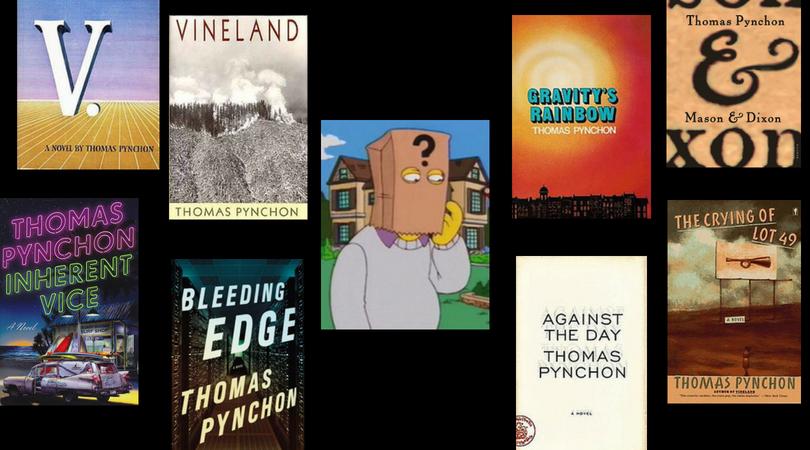
Every weirdo in the world is on my wavelength.
Here we are in the high, roiling heat of midsummer and depending on where you live in these United States, you may be soaking up a sea breeze or watching the flat midwest horizon shimmer or stewing in a crowded city subway car. Wherever you are, though, and whatever you’re doing, there is one thing I think we can all agree on: nothing says Fun in the Sun like the work of legendarily reclusive wordsmith Thomas Ruggles Pynchon Jr (yes, his middle name really is Ruggles). Right?
Pynchon’s intriguingly dense and zany books, coupled with his ability to maintain his winking hermit persona (unlike, say, the more po-faced, humorless variety practiced by J.D. Salinger) deep into the all-seeing Information Age, has imbued him with a cult status almost without parallel among living authors. In fact, I’d wager that if you lock the doors on any medium to large-sized MFA class or gathering of Aspiring Literary Writers of America, and force everyone to unveil their tattoos, you’ll find at least one Trystero symbol from The Crying of Lot 49 per group.
Ordinarily we like to pin review retrospectives to anniversaries, but today, for no particular reason other than we felt like it, here are the first reviews of every one of beloved weirdo Thomas Pynchon’s novels, from V. (1963) to Bleeding Edge (2013).
*
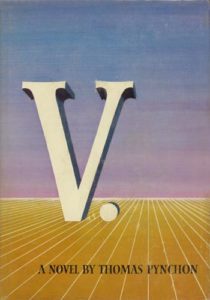
V. (1963)
Life’s single lesson: that there is more accident to it than a man can ever admit to in a lifetime and stay sane.
“For the author, the form of the picaresque is convenient: he can string together the short stories he has at hand (publishers are reluctant to publish short-story collections, which would suggest the genre is perhaps a type of compensation). Moreover—the well-made, the realistic not being his concern—the author can afford to take chances, to be excessive, even prolix, knowing that in a work of great length stretches of doubtful value can be excused. The author can tell his favorite jokes, throw in a song, indulge in a fantasy or so, include his own verse, display an intimate knowledge of such disparate subjects as physics, astronomy, art, jazz, how a nose-job is done, the wildlife in the New York sewage system. These indeed are some of the topics which constitute a recent and remarkable example of the genre: a brilliant and turbulent first novel published this month by a young Cornell graduate, Thomas Pynchon. He calls his book V.
…
“The identity of V., what her many guises are meant to suggest, will cause much speculation. What will be remembered, whether or not V. remains elusive, is Pynchon’s remarkable ability—which includes a vigorous and imaginative style, a robust humor, a tremendous reservoir of information (one suspects that he could churn out a passable almanac in a fortnight’s time) and, above all, a sense of how to use and balance these talents. True, in a plan as complicated and varied as a Hieronymus Bosch triptych, sections turn up which are dull—the author backing and filling, shuffling the pieces of his enormous puzzle to no effect—but these stretches are far fewer than one might expect. Pynchon is in his early twenties; he writes in Mexico City—a recluse. It is hard to find out anything more about him. At least there is at hand a testament— this first novel V.—which suggests that no matter what his circumstances, or where he’s doing it, there is at work a young writer of staggering promise.”
–George Plimpton, The New York Times, April 21, 1963
*
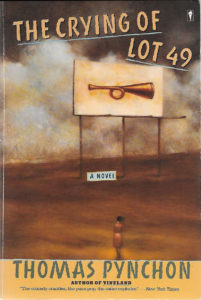
The Crying of Lot 49 (1966)
Shall I project a world?
“This novel is a patriotic lamentation, an elaborate effort not to believe the worst about the Republic. Patriotism for an ideal of America explains the otherwise yawning gap in Pynchon’s comic shaping of his material. The Tristero System—it began in 1577 in Holland in opposition to the Thurn and Taxis Postal System and is active now in America trying to subvert the American postal system through an organization called W.A.S.T.E.—is a masterpiece of comic invention. It involves, among other things, one of the best parodies ever written of Jacobean drama, The Courier’s Tragedy, and a perhaps final parody of California right-wing organizations, Peter Pequid Society, named for the commanding officer of the Confederate man-of-war ‘Disgruntled’ and opposed to industrial capitalism on the grounds that it has led inevitably to Marxism. Its leader, Mike Fallopian, speculates in California real estate.
The exuberance of such comedy softens the portents of national calamity, but at the same time it makes it nearly impossible for Pynchon to persuade the reader, as he anxiously wants to do, that the whole System and the whole book have more meaning than a practical joke. The same difficulty was apparent in V., where the author’s style at points of sincerity about love and youth was, by contrast to the vitality of his comic writing, platitudinously limp and sloganeering.
…
“In fact, Pynchon’s best writing is often in his descriptions of American scenery, of objects rather than persons. He shows at such points a tenderness, largely missing from our literature since Dreiser, for the very physical waste of our yearnings, for the anonymous scrap heap of Things wherein our lives are finally joined. The Pynchon who can write with dashing metaphoric skill about the way humans have become Things, can also reveal a beautiful and heartbreaking reverence for the human penetration of the Thingness of this country, the signatures we make on the grossest evidences of our existence.”
–Richard Poirier, The New York Times, May 1, 1966
*

Gravity’s Rainbow (1973)
If they can get you asking the wrong questions, they don’t have to worry about answers.
“Pynchon’s new book is thus an event—it breaks seven years of silence and allays the fear that he might never go beyond his early success. Gravity’s Rainbow is longer, darker and more difficult than his first two books; in fact it is the longest, most difficult and most ambitious novel to appear here since Nabokov’s Ada four years ago; its technical and verbal resources bring to mind Melville and Faulkner. Immersing himself in ‘the destructive element’ and exploring paranoia, entropy and the love of death as primary forces in the history of our time, Pynchon establishes his imaginative continuity with the great modernist writers of the early years of this century. Gravity’s Rainbow is bonecrushingly dense, compulsively elaborate, silly, obscene, funny, tragic, pastoral, historical, philosophical, poetic, grindingly dull, inspired, horrific, cold, bloated, beached and blasted.
…
“The risk that Pynchon’s fiction runs is boredom, repetition without significant development, elaboration that is no more than compulsiveness. For all its richness and exuberance, V. is more a wonderful, concatenated jigsaw puzzle than an esthetically coherent literary structure. The Crying of Lot 49 is smaller but better built. In Gravity’s Rainbow the structure is strained beyond the breaking point. Reading it is often profoundly exasperating; the book is too long and dense; despite the cornucopia of brilliant details and grand themes, one’s dominant feelings in the last one to two hundred pages are a mounting restlessness, fatigue and frustration. The book doesn’t feel ‘together.’”
–Richard Locke, The New York Times, March 11, 1973
*
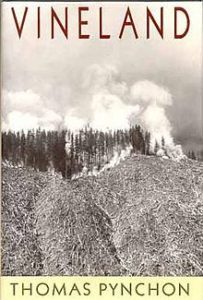
Vineland (1990)
What we cry, what we contend for, in our world of toil and blood,
it all lies beneath the notice of the hacker we call God.
“So, he’s back, and the question that occurs to you on finishing Vineland is, what took him so long? Because this doesn’t feel like a book written to break a block; it isn’t congested or stop-start or stiff; matter of fact, it’s free-flowing and light and funny and maybe the most readily accessible piece of writing the old Invisible Man ever came up with. It is also not the book we thought Thomas Pynchon was writing.
…
“There is enough in Vineland to obsess the true, mainlining Pynchomane for a goodly time … But what is perhaps most interesting, finally, about Mr. Pynchon’s new novel is what is different about it. What is interesting is the willingness with which he addresses, directly, the political development of the United States, and the slow (but not total) steamrollering of a radical tradition many generations and decades older than flower power … What is interesting is to have before us, at the end of the Greed Decade, that rarest of birds: a major political novel about what America has been doing to itself, to its children, all these many years. And as Thomas Pynchon turns his attention to the nightmares of the present rather than the past, his touch becomes lighter, funnier, more deadly. And most interesting of all this is that aforementioned hint of redemption, because this time entropy is not the only counterweight to power; community, it is suggested, might be another, and individuality, and family. These are the values the Nixon-Reagan era stole from the 60’s and warped, aiming them back at America as weapons of control. They are values that Vineland seeks to recapture, by remembering what they meant before the dirt got thrown all over them, by recalling the beauty of Frenesi Gates before she turned.
Thomas Pynchon is no sentimentalist, however, and the balance between light and dark is expertly held throughout this novel, so that we remain uncertain until the final pages as to which will prevail, hippie heaven or Federal nemesis. And we are left, at the last, with an image of such shockingly apt moral ambiguity that it would be quite wrong to reveal it here.
Vineland, Mr. Pynchon’s mythical piece of northern California, is, of course, also ‘Vinland,’ the country discovered by the Viking Leif Ericsson long before Columbus. It is ‘Vineland the Good’; that is to say, this crazed patch of California stands for America itself. And it is here, to Vineland, that one of America’s great writers has, after long wanderings down his uncharted roads, come triumphantly home.”
–Salman Rushdie, The New York Times, January 14, 1990
*
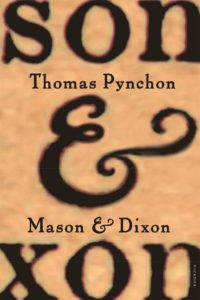
Mason & Dixon (1997)
The general public has long been divided into two parts;
those who think that science can do anything and those who are afraid it will.
“In Mr. Pynchon’s rendering, Charles Mason and Jeremiah Dixon make up the classic comedy team of straight man and flake, Mason the melancholic widower attached to the Astronomer Royal, however tenuously, and Dixon the boisterous surveyor and man of the people for whom the madcap is just another reflex.
…
“The style is playful, a pastiche redolent of the musty journal and the capitalomania of the day, bumptiously Fieldingesque, and yet as pumped-up and heightened and chock-full of late-20th-century references as the dernier cri from the street. It is wonderfully subversive. In fact, almost all the book’s humor is balanced on the razor edge of anachronism, creating a rich stew of accepted and invented history, anecdote, myth and hyperbole.
There are precedents here—John Barth, Robert Coover, Gunter Grass, Gabriel Garcia Marquez, E. L. Doctorow and, of course, the Thomas Pynchon of Gravity’s Rainbow and V. Mr. Barth comes particularly to mind, and a good part of the fun of Mason & Dixon lies in its allusiveness and self-awareness … The broad wink at history is affectionate and warm, never dismissive, because history is a place in which to live, one version of many, a novel unfolded and unfolding still to affect us in any number of unforeseen ways. If the future is uncertain, so is the past.
…
“The method is sublime. It allows for the surveyors’ story to become an investigation into the order of the universe, clockwork deity and all, and yet at the same time to reflect the inadequacy of reason alone to explain the mystery that surrounds us. The haunted world, the suprareal, the ghostly and the impossible have the same valence as the facts of history as we receive them. If the traditional historical novel attempts to replicate a way of life, speech and costume, the post-modernist version seeks only to be just that, a version.
…
“What is remarkable about this book, aside from its sheer entertainment value, is how well this method works. For all its profuse detail, its jokes and songs and absurdities, the book nonetheless evokes its time and place better than any historical novel I can recall. As in Gravity’s Rainbow, the author shows a magical ability to dwell effortlessly in the past.
…
“For those who were puzzled by Vineland, and its sense of the original hipster striving gallantly to radiate the full spectrum of hip, the news here is nothing but good. This is the old Pynchon, the true Pynchon, the best Pynchon of all. Mason & Dixon is a groundbreaking book, a book of heart and fire and genius, and there is nothing quite like it in our literature, except maybe V. and Gravity’s Rainbow.”
–T. Coraghessan Boyle, The New York Times, May 18, 1997
*

Against the Day (2006)
Time is never wasted if you remember to bring along something to read.
“The fun of Pynchon’s books—and they are in fact more fun than not, and this is for better and worse one of the key differences between Pynchon and the major novelists who preceded him—has always been to read them into the present. Gravity’s Rainbow, while ostensibly about World War II, was actually about American Cold War hegemony and Vietnam; Against the Day likewise works with what feels like contemporary material, though its subject is ostensibly the turn of the twentieth century. The route of railroad tracks determined political arrangements then, just as oil pipelines do now; anarchists (or terrorists) blew them up; and all of this was watched from above by capitalists and air-balloon enthusiasts. The great invention of the mid-nineteenth century was dynamite, used by miners to blow railroad tunnels through mountains, then by anarchists to blow the railroad tracks into the sky. By the end of the century, the latest invention was wireless, and everyone was in a race to use it, for profit and for glory.
Part of the reason Pynchon is a more important writer than his successors William Vollmann and Richard Powers is that he’s politically more radical and more committed (he can also construct sentences, and sometimes even edit them)—and his view of power is tirelessly grim, if also cartoonish. Against the Day is very much against the present day. At the same time, it holds out a kind of hope, in the very technologies it knows are being used to destroy human freedom. Frank, for example, finds something bewitching in the photograph of the two killers, something in the eyes, which are ‘rendered with that same curious crazed radiance which once was an artifact of having to blink a couple of hundred times during the exposure, but in this more modern form due to something authentically ghostly, for which these emulsions were acting as agents, revealing what no other record up till then could’ve.’
Photography actually catches the human ghost, and traps it. But also reveals it—that’s the word he uses. Maybe Pynchon will sit for one. Maybe he won’t. It doesn’t actually matter anymore. Thomas Pynchon has always been paranoid, but now, finally, the world has caught up.”
–Keith Gessen, New York Magazine, November 25, 2007
*
Inherent Vice (2009)
Questions arose. Like, what in the fuck was going on here, basically.
“Inherent Vice is Thomas Pynchon doing Raymond Chandler through a Jim Rockford looking glass, starring Cheech Marin (or maybe Tommy Chong). What could easily be mistaken as a paean to 1960s Southern California is also a sly herald of that era’s end. This, of course, is exactly the kind of layered meaning that readers expect of Pynchon.
…
“In classic Pynchon fashion, random incidents add up to conspiracy—maybe. Behind powerful figures loom shadowy, more powerful figures, and complex layers of knowledge lead to confusion as much as clarity. There is also a lot of sex (if little romance), many pop-culture allusions (one scene references at least two classic noir films), characters who cross over from Pynchon’s other work (Vineland, predominantly) and silly names galore … If Inherent Vice exhibits nostalgia, it is not for the Los Angeles of yesteryear but for the days when genuine mystery was possible, when Doc’s acid trip could be as relevant as Det. Bjornsen’s world, when complex layers could both contradict and coexist. It’s a love letter to a time when obsessives couldn’t get all the answers from computers, when we might embrace the unknowable.
It’s easy to forget, among all his games and puzzles, that Pynchon can write razor-sharp beauty with the best of them. A page-long description of the Santa Anas demands a place next to classic passages by Chandler and Joan Didion.
In Pynchon’s big books, these devastating descriptions, particularly of place, are often swept away in the tide of prose and characters. Here, in a novel that focuses on Los Angeles so sharply that Tommy’s is pinpointed by its cross streets, they shine.
…
“…after getting pretty far out, Inherent Vice eventually circles back and ties up all its loose ends. It has a climactic moment, a cushiony denouement—by gum, closure. If this stands in counterpoint to Pynchon’s most acclaimed work, perhaps we should pay heed to the novel’s title: Inherent Vice refers to a hidden defect that undermines a property’s worth, a marine-legal term for a Shakespearean flaw. It could refer to Los Angeles; it could refer to the 1960s. Or it could refer to the author’s work itself: With Pynchon’s brilliance comes readability.”
–Carolyn Kellogg, The Los Angeles Times, August 2, 2009
*
Bleeding Edge (2013)
Culture attracts the worst impulses of the moneyed, it has no honor, it begs to be suburbanized and corrupted.
“It’s tempting to suppose that Bleeding Edge has been written, in part, as a response to the Pynchonization of consensus reality, a transformation that became irrefutable with the rise of the World Wide Web, with its name like that of a global crime syndicate out of some half-parodic James Coburn spy caper and its infinite interlinks a perfect metaphor for paranoia itself. Having nuzzled up to the subject briefly in Inherent Vice, Pynchon digs deep, here, into the history of the WWW (V. sextupled?), from the DARPAnet Cretaceous of 1969 to the dot-com bust at the turn of the millennium … A good postmodernist, like a 9/11 truther, can afford the luxury of disdain for innocence; a parent is bound to protect it. Bleeding Edge is best understood not as the account of a master of ironized paranoia coming to grips with the cultural paradigm he helped to define but as something much braver and riskier: an attempt to acknowledge, even at the risk of a melodramatic organ chord, that paradigm’s most painful limitation.”
–Michael Chabon, The New York Review of Books, November 7, 2013

